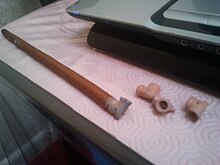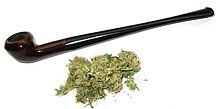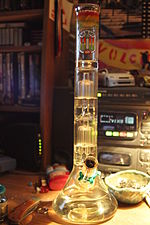| Revision as of 22:51, 7 October 2023 editDiscospinster (talk | contribs)Administrators465,273 editsm Reverted edits by 2601:C6:D700:FA10:151E:2AC1:C6C0:6D07 (talk) (HG) (3.4.12)Tags: Huggle Rollback← Previous edit | Revision as of 20:28, 10 November 2023 edit undo2601:681:5d81:8e60:cdad:250b:2e05:47c9 (talk)No edit summaryTags: Reverted references removed Mobile edit Mobile web editNext edit → | ||
| Line 5: | Line 5: | ||
| {{Cannabis sidebar}} | {{Cannabis sidebar}} | ||
| '''Cannabis smoking''' (known ] as '''smoking weed''' or '''smoking pot''') is the inhalation of smoke or vapor released by heating the flowers, leaves, or extracts of ] and releasing the main ], Δ<sup>9</sup>-] (THC), which is absorbed into the ] via the ]. Archaeological evidence indicates cannabis with high levels of THC |
'''Cannabis smoking''' (known ] as '''smoking weed''' or '''smoking pot''') is the inhalation of smoke or vapor released by heating the flowers, leaves, or extracts of ] and releasing the main ], Δ<sup>9</sup>-] (THC), which is absorbed into the ] via the ]. Archaeological evidence indicates cannabis with high levels of THC fer from other ] in having a more rapid and predictable onset of effect.<ref>{{citation |url=https://www.erowid.org/plants/cannabis/cannabis_effects.shtml |title=Cannabis (Marijuana) Vault : Effects |publisher=Erowid.org |access-date=23 February 2011 |archive-url=https://web.archive.org/web/20110417104542/https://www.erowid.org/plants/cannabis/cannabis_effects.shtml |archive-date=17 April 2011 |url-status=live }}</ref> | ||
| In addition to being smoked and ], cannabis and its active ]s may be ], ], or applied to the skin. The ] characteristics and effects of smoking and vaporizing cannabis differ from other ] in having a more rapid and predictable onset of effect.<ref>{{citation |url=https://www.erowid.org/plants/cannabis/cannabis_effects.shtml |title=Cannabis (Marijuana) Vault : Effects |publisher=Erowid.org |access-date=23 February 2011 |archive-url=https://web.archive.org/web/20110417104542/https://www.erowid.org/plants/cannabis/cannabis_effects.shtml |archive-date=17 April 2011 |url-status=live }}</ref> | |||
| == Methods == | == Methods == | ||
Revision as of 20:28, 10 November 2023
Inhalation of marijuana fumesThis article is about smoking practices. For drug information, see Cannabis (drug). For other uses, see Cannabis (disambiguation).

| Part of a series on |
| Cannabis |
|---|
 |
|
Chemistry
|
Pharmacology
|
| Consumption |
| Economics |
| Effects |
| Forms |
Law
|
Variants
|
| Related |
Cannabis smoking (known colloquially as smoking weed or smoking pot) is the inhalation of smoke or vapor released by heating the flowers, leaves, or extracts of cannabis and releasing the main psychoactive chemical, Δ-tetrahydrocannabinol (THC), which is absorbed into the bloodstream via the lungs. Archaeological evidence indicates cannabis with high levels of THC fer from other cannabis consumption methods in having a more rapid and predictable onset of effect.
Methods

Cannabis (marijuana) can be smoked in a variety of pipe-like implements made in different shapes and of different materials including hand pipes ("bowls"), water pipes ("bongs"), cigarettes ("joints"), or blunts.
Solar puffing (also called "solar toking", "taking solar hits”, or “solar bowls” ) is the act of using the sun's rays with a magnifying lens or burning glass to heat cannabis for consumption.
Hotboxing involves multiple persons smoking cannabis in an enclosed space, such as a car, with no way for smoke to escape. In addition to the primary smoke from the chosen smoking devices, second hand smoke is repeatedly inhaled and exhaled. A single user breathing in and out of a breathbonnet (breadbag) can achieve this effect.
Vaporization
Main article: Vaporizer (inhalation device) § Cannabis vaporizersVaporizers (vape pens and/or stationary platform) are devices used to extract the active ingredients of cannabis, tobacco (E-cigarettes), or any plant material at lower than burning temperature, eliminating carbon monoxide and carcinogenic "tars" found hazardous in smoke. 197 °C / 385 °F is frequently mentioned as a good vaporizing temperature for favored cannabinoids. Utensils usually thought of as smoking pipes can be used to vaporize if the receptacle, or "bowl", is narrow enough to permit controlling the inward flow of heated air from a source such as a lighter which is held far enough below the opening.
According to the journal Clinical Pharmacology & Therapeutics, vaporizing cannabis is a safe and more effective way (than smoking) of delivering THC to patients for medical uses. The feasibility of vaporization of THC has been demonstrated in a series of laboratory studies involving different vaporizer designs. An electric vaporizer was shown to release substantial amounts of the THC while producing no measurable amounts of benzene, toluene, and naphthalene, which are generated when marijuana is smoked.
Smoking
Health effects of smoking
Main articles: Effects of cannabis and Long-term effects of cannabisSome data on the correlation of an increase in the incidence of lung cancer and cannabis smoking are conflicting. A systematic review evaluating 19 studies from 1966 to 2006 found no significant tobacco-adjusted association between cannabis smoking and lung cancer development despite evidence of precancerous histopathologic changes of the respiratory mucosa.
Cannabis smoke was listed as a cancer agent in California in 2009. Cannabis smoke contains many of the same carcinogens as tar from tobacco smoke.
A 2012 literature survey by the British Lung Foundation identified cannabis smoke as a carcinogen and also found awareness of the danger was low, with 40% of under 35s thinking that cannabis (when smoked) was not harmful. Other observations include lack of research on the effect of cannabis smoke alone due to common mixing of cannabis and tobacco and frequent cigarette smoking by cannabis users; low rate of addiction compared to tobacco; and episodic nature of cannabis use compared to steady frequent smoking of tobacco.
A 2013 literature review said that exposure to cannabis had biologically based physical, mental, behavioral and social health consequences and was "associated with diseases of the liver (particularly with co-existing hepatitis C), lungs, heart, and vasculature". The authors cautioned that "evidence is needed, and further research should be considered, to prove causal associations of marijuana with many physical health conditions".
Materials
Disposable materials
Disposable materials are often used in places where cannabis is illegal.
A roach is the remains of a joint, blunt or roll up cigarette after most of it has been smoked.
Joint
Main article: Joint (cannabis)Joint is a slang term for a cigarette filled with cannabis instead of tobacco. Alternatively, mainly in Europe, joints may contain tobacco (commonly dubbed "a spliff", but not to be confused with the Jamaican term Spliff, which refers to a large joint) or various non-addictive herbs. Sometimes a joint will contain kief or hashish; hashish can be heated and made to crumble before placement within the joint. Specially manufactured rolling papers are most often used in industrialized countries; however, recycled brown paper and newspaper are commonly used in the developing world. Modern papers are now made from a wide variety of materials including rice, hemp, soy, and flax. A joint typically contains 250–750 mg net weight of cannabis and/or fillers.
Blunt
Main article: Blunt (cannabis)A blunt is cannabis rolled with a cigar wrapper (usually tobacco leaf, which contains nicotine). Blunts are often made with blunt wraps: tobacco-based wraps — often flavored — that are related to the wraps used on a blunt cigar and are often used to roll cannabis Blunts can also now be rolled with Hemp wraps that do not contain Nicotine. There are several types available in varying flavors as an alternative to using a cigar wrapper, for those people who don't desire the nicotine.
Reusable materials
Pipe or bowl
"Pinchie" redirects here. For the town in Canada, see Pinchie, British Columbia. Main article: Bowl (smoking)
Pipes made for smoking cannabis, sometimes called pieces or bowls, are made of a variety of materials, including metal fittings, ceramic, borosilicate glass, stone, wood, bamboo among other materials. Subtypes include one-hitters, bubblers, chillums, glass blunts, corn cob pipes, and standard hand pipes. Pipes vary greatly in shape and materials, and most are handmade. The common thread between them is having a narrow screened receptacle ("bowl"), a "stem" (which may be a long flexible tube as on hookahs and vaporizers), and a "mouthpiece". The smoking material is placed in the receptacle and affected with a heat source while air is drawn through the bowl and stem to the user.
Blown-glass pipes and bongs are often intricately and colorfully designed. In India and Jamaica, the most commonly used pipe is the chillum.; in the UAE, midwakh; in Morocco, sebsi.
- A one-hitter is a device used for a single serving (usually 25 mg).
- Chalice is a cannabis smoking pipe used most often by members of the Jamaican Rastafari movement.
Bubbler
A bubbler is a mix of a bong and a pipe. They tend to look like small bongs and are another way to smoke cannabis. A bubbler contains a chamber for water, commonly with a down stem directly connected to the bowl of the piece. A bubbler normally has a dedicated carburetor, a hole which is usually covered with the finger then opened for mixing clean air with the smoke to make inhaling easier. Because of the carburetor there is no need to pull the stem as you would with a bong.
Bong
Main article: Bong
A bong is similar to a pipe, only it has a water-chamber through which cannabis smoke passes prior to inhalation. Users fill the bong with water, sometimes also adding ice in order to cool the smoke. This cooling effect reduces the discomfort caused by the heat of the smoke. The bowl and stem assembly of most bongs is removed briefly after the cannabis is burned, allowing clean air to circulate and clear the smoke chamber, ensuring no smoke dissipates without being properly consumed.
Types of bongs:
- Classical bongs.
- Gravity bong (also known as a grav, bucket, bucky (in New Zealand), submarine, geeb, or GB) is a hydropneumatic device used for smoking cannabis. A typical variant consists of a bucket of water in which is typically placed a bottle with the bottom cut off, such as a 2-litre PET soft drink bottle. However, commercial gravity bongs made of borosilicate glass exist too. Some kind of cap or screen is rigged over the mouth of the bottle and filled with hash or cannabis. A flame is then held near enough to heat the drug while the bottle is slowly raised out of the water, creating a negative gauge pressure inside the bottle, drawing smoke from the heated cannabis—along with air—into the vacuum. The cap or screen is removed once the bottle is almost full, the user's mouth is placed over the mouth of the bottle and the bottle pushed back down into the water, causing the pressure to rise and forcing the smoke into the lungs. There are many variants on this basic premise, such as using a large water cooler tank in lieu of a soft drink bottle.
- Waterfall bong: Similar to a gravity bong, a waterfall bong utilizes both a bottle and a cap or screen rigged over the bottle's mouth to hold cannabis. In this case, however, the bottle—which has one or several holes drilled near or at the bottom—is either filled with water or placed in a larger container filled with water before the cannabis is packed. The holes are then uncovered, or the bottle is simply raised from the container, evacuating the water either onto the ground or back into the container. When heat is applied to the drug, the resultant smoke is forced into the bottle with negative gauge pressure, as with the gravity bong. Once the water is evacuated, the smoke can be inhaled from the bottle. Variations on this concept are also used. Commercial gravity bongs made of borosilicate glass exist too.
Spots
Main article: Spots (cannabis)

Spotting refers to a method of smoking cannabis. In this method, small pieces of cannabis are rolled (or simply torn from a larger bud) to form the "spot". Generally, the tips of two knife blades are heated, the spot is compressed between the two blades, and the subsequent smoke is inhaled through the nose or mouth. This method of smoking is also referred to as "hot knives" because of the heated blades. Another means is specially made glass presses heated with a propane or butane torch. In order to facilitate this process, a "spottle" (also referred to as a "bowser", "hooter" or "toker") is often, but not always, used to funnel the smoke and maximize the amount inhaled. A spottle is generally made from a funnel or cone-shaped container, such as the top (or neck) of a plastic or glass bottle or a gallon of milk/water.
See also
References
- Cannabis (Marijuana) Vault : Effects, Erowid.org, archived from the original on 17 April 2011, retrieved 23 February 2011
- United Nations Office on Drugs and Crime (2006). World Drug Report (PDF). Vol. 1. pp. 187–192. ISBN 978-92-1-148214-0. Archived (PDF) from the original on 7 October 2007. Retrieved 22 November 2007.
- "Solar Bowls". Archived from the original on 21 September 2008. Retrieved 7 February 2009.
- Lutchmansingh, D; Pawar, L; Savici, D (2014). "Legalizing Cannabis: A physician's primer on the pulmonary effects of marijuana". Current Respiratory Care Reports. 3 (4): 200–205. doi:10.1007/s13665-014-0093-1. PMC 4226845. PMID 25401045.
- Abrams, DI; Vizoso, HP; Shade, SB; Jay, C; Kelly, ME; Benowitz, NL (November 2007). "Vaporization as a Smokeless Cannabis Delivery System: A Pilot Study". Clinical Pharmacology. 82 (5): 572–578. doi:10.1038/sj.clpt.6100200. PMID 17429350. S2CID 14629288.
- Dale H. Gieringer. "Cannabis "Vaporization : A Promising Strategy for Smoke Harm Reduction" (PDF). Cannabis-med.org. Archived (PDF) from the original on 28 April 2018. Retrieved 9 April 2018.
- Abrams, D. I.; Vizoso, H. P.; Shade, S. B.; Jay, C.; Kelly, M. E.; Benowitz, N. L. (2007). "Vaporization as a Smokeless Cannabis Delivery System: A Pilot Study". Clinical Pharmacology & Therapeutics. 82 (5): 572–578. doi:10.1038/sj.clpt.6100200. PMID 17429350. S2CID 14629288.
- Mehra; et al. (10 July 2006), "The Association Between Marijuana Smoking and Lung Cancer", Archives of Internal Medicine, 166 (13): 1359–1367, doi:10.1001/archinte.166.13.1359, PMID 16832000, S2CID 10117687
- Chemicals known to the state to cause cancer or reproductive toxicity (PDF), ca.gov, 20 July 2012, archived from the original (PDF) on 20 January 2013, retrieved 8 January 2013
- Tomar, Rajpal C.; Beaumont, Jay; Hsieh, Jennifer C.Y. (August 2009), Evidence on the carcinogenicity of marijuana smoke (PDF), Reproductive and Cancer Hazard Assessment Branch Office of Environmental Health Hazard Assessment, California Environmental Protection Agency, archived (PDF) from the original on 24 July 2012, retrieved 23 June 2012
- The impact of cannabis on your lungs, British Lung Association, June 2012, archived from the original on 27 September 2013, retrieved 9 January 2013
- Gordon AJ, Conley JW, Gordon JM (December 2013). "Medical consequences of marijuana use: a review of current literature". Curr Psychiatry Rep (Review). 15 (12): 419. doi:10.1007/s11920-013-0419-7. PMID 24234874. S2CID 29063282. Archived from the original on 7 August 2019. Retrieved 30 June 2019.
- "Roach". Thefreedictionary.com. Retrieved 9 April 2018 – via The Free Dictionary.
- Barrett, Leonard (1988). The Rastafarians: Twentieth Anniversary Edition. Beacon Press. p. 130. ISBN 978-0-8070-1039-6. Archived from the original on 11 October 2013. Retrieved 9 May 2013.
- "Roll Your Own Magazine – Papers", Winter-Spring 2008, Ryomagazine.com, 2008, archived from the original on 21 July 2011, retrieved 20 April 2011
- World Health Organization: Division of Mental Health and Prevention of Substance Abuse (1997). Cannabis: a health perspective and research agenda (PDF). p. 11. WHO/MSA/PSA/97.4. Archived from the original (PDF) on 23 December 2014. Retrieved 15 July 2011.
- How is marijuana abused?, nida.nih.gov, 2012, archived from the original on 28 December 2011, retrieved 15 October 2019
- Brown, Jessica E.; Luo, Wentai; Isabelle, Lorne M.; Pankow, James F. (5 June 2014). "Candy Flavorings in Tobacco". New England Journal of Medicine. 370 (23): 2250–2252. doi:10.1056/NEJMc1403015. ISSN 0028-4793. PMID 24805984.
- "Handbook of Pharmacy Education", Harmen R.J., 2001, Pg 169
- McBride, A. (1995). "Cannabis use in a drug and alcohol clinic population". Drug and Alcohol Dependence. 39 (1): 29–32. doi:10.1016/0376-8716(95)01132-I. PMID 7587971.
- "Understanding street drugs: a handbook of substance misuse for parents, teachers and other professionals", Emmett D. & Nice G. 2006, Pg 41
- "James Bong's Ultimate SpyGuide to Marijuana", Arooka, Pg 186
External links
 Media related to Cannabis smoking at Wikimedia Commons
Media related to Cannabis smoking at Wikimedia Commons
| Cannabis | |||||||||
|---|---|---|---|---|---|---|---|---|---|
| General | |||||||||
| Usage |
| ||||||||
| Variants | |||||||||
| Effects |
| ||||||||
| Culture | |||||||||
| Organizations |
| ||||||||
| Demographics | |||||||||
| Politics |
| ||||||||
| Related | |||||||||